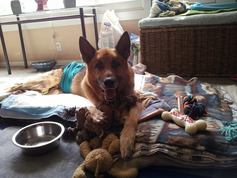You may have heard on the
news recently about a new canine flu affecting dogs in the Midwest (especially
the Chicago area). It is a new Asian
strain called H3N2. We have not seen it previously in the United States, so
your dog will not have immunity to this virus and there is not a vaccine
available in the United States. It is highly contagious and precautions should
be taken, especially if cases have been identified in your area.
The symptoms are similar
to the American canine flu H3N8 and include: coughing,
sneezing and a runny nose. There has also been reports that many dogs infected
by the H3N2 will develop pneumonia. It is also important to note that canine
flu does not have a “flu season” like human influenza so pets can be infected all
year. The American
Veterinary Medical Association
says, "Canine influenza is spread via
aerosolized respiratory secretions and contaminated objects (kennel surfaces,
food and water bowls, collars and leashes) and people moving between infected
and uninfected dogs. The virus can remain viable (alive and able to infect) on
surfaces for up to 48 hours, on clothing for 24 hours and on hands for 12
hours."
If your dog is diagnosed with H3N2, be sure they
are eating a healthy diet, getting plenty of rest and fluids
and watch for secondary infections (like pneumonia). Holistic supplements especially immune support supplements such as Quentans which is anti-viral can greatly help. Keep an infected dog
away from other dogs! They could be contagious for at least 10-14 days.
Since there is not a vaccine, prevention is
the key to keeping your pet healthy. Avoid areas that have documented cases of H3N2,
especially places with high contact, dog care centers, training classes, dog
parks, etc. and build your pets natural immune system with supplements such as
Amazing Omegas for Pets and Power Probiotics for Pets


















